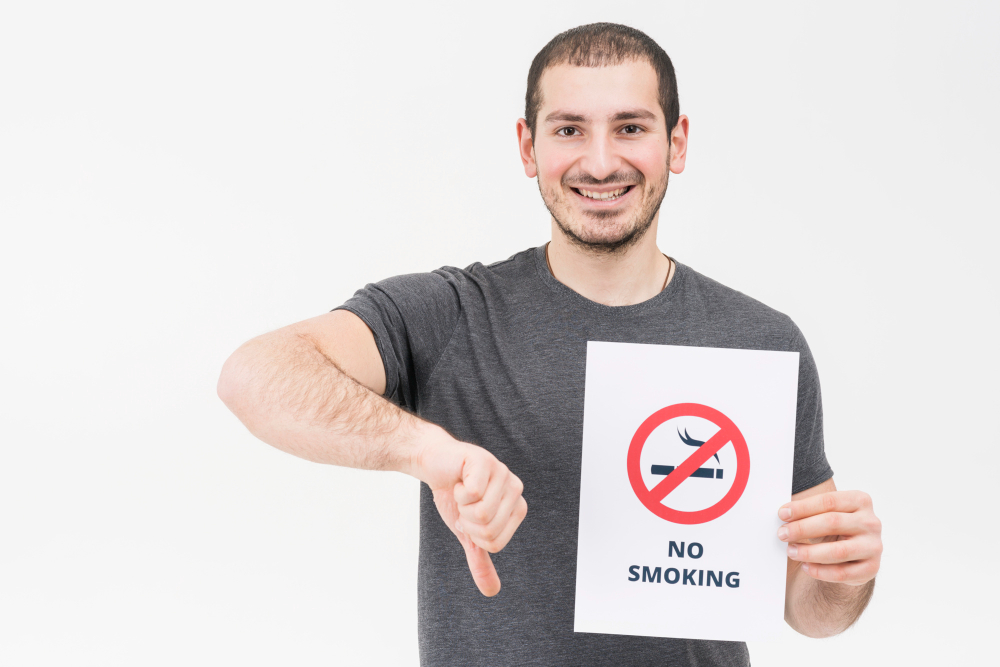Why isn’t willpower enough?
If you’re reading this, chances are you’ve already thought about quitting cigarettes more than once. Maybe a doctor told you it was time, or a partner begged you to stop. Maybe you’ve tried patches, apps, hypnosis or sheer willpower. Maybe you’ve promised yourself tomorrow will be different, only to find yourself standing outside at 3 AM, cigarette in hand.
According to 2022 data from the U.S. Centers for Disease Control and Prevention (CDC), 67.7 % of adult smokers said they wanted to quit and 53.3 % attempted to quit in the past year, but only about 8.8 % succeeded. That means fewer than one in ten people who try to quit succeed during any given year.
Why do so many of us fail when we desperately want to stop? The simple answer is that quitting is all about recognising and navigating the hidden roadblocks biological, psychological, social and environmental that make smoking so hard to leave behind, not just . This article explores those obstacles in depth, drawing on current research and lived experience. We’ll look at what nicotine does to your body, why withdrawal feels unbearable, how stress and mental health play into your addictio, and why fear of weight gain or failure can keep you chained to cigarettes. We’ll also share practical strategies, including how simplified nicotine replacement therapy (NRT) can help and real‑world success stories to show that you’re not alone in this journey.
Nicotine and the brain: a match made in dependence
If you’ve ever wondered why it feels like cigarettes have a grip on your brain, it’s because they literally do. Nicotine is the chemical compound that makes tobacco products addictive. When you inhale cigarette smoke, nicotine travels quickly to your brain, triggering a flood of neurotransmitters like dopamine, the feel‑good chemical associated with pleasure and reward. The U.S. Food and Drug Administration (FDA) explains that because cigarettes deliver nicotine rapidly, smokers become dependent on these quick bursts, leading to cravings and withdrawal symptoms when nicotine levels drop. Over time, your brain adapts to this constant stimulation by reducing its own production of dopamine, meaning you need more nicotine just to feel normal.
The addictive nature of nicotine doesn’t stop at cravings. It can also cause long‑term changes in the brain. According to an FDA report, nicotine dependence can alter neural circuits, reinforcing both the physical act of smoking and the emotional associations attached to it.. That’s why quitting can feel like losing an old friend. Your brain has been conditioned to associate a cigarette with everything from morning coffee to a post‑meal reward, and those associations take time to unlearn.
Withdrawal: what your body goes through
Understanding nicotine’s grip helps explain why withdrawal is so brutal. When you stop smoking, your body goes into withdrawal because it is no longer receiving the regular nicotine fix it expects. Physical symptoms, such as irritability, restlessness, increased appetite, headaches and difficulty concentrating,can be intense for the first few days. Smokefree.gov notes that most physical withdrawal symptoms subside after a week, but psychological cravings can persist for months. This is because nicotine has rewired your brain to expect regular dopamine boosts, and it takes time to recalibrate.
On top of withdrawal, certain triggers can make quitting harder. Seeing someone smoke, having a cup of coffee or experiencing stress can all cause craving. Many smokers will light up after meals or during work breaks without even realising it. Breaking these associations requires planning, self‑awareness and alternative coping strategies.
Psychological roadblocks: fear, loss and self‑identity
Research shows that some of the biggest obstacles to quitting are not physical but psychological. A qualitative study among smoking cessation specialists in Germany found that fear of failure is a significant barrier. People worry they’ll try again and disappoint themselves or their loved ones. This fear often stems from previous failed attempts and the belief that quitting is an insurmountable challenge. Fear of loss is another common theme, smokers see cigarettes as a “good friend” that brings comfort or pleasure. The idea of losing that companion can be terrifying, particularly if cigarettes have been used to cope with loneliness, anxiety or sadness.
Smokers also develop strong cognitive attachments to cigarettes. Some believe that nicotine satisfies multiple needs, providing comfort, helping them think, or serving as a reward for hard work. Others justify continued smoking with thoughts like “I only live once” or “why should I stop now?” These thought patterns can make quitting seem pointless or even unfair. Addressing these beliefs and reframing your relationship with cigarettes is a crucial part of quitting.
Mental health: a double burden
Mental health issues can both lead to and result from smoking. A review of smoking and mental health found that people with depression and anxiety smoke more heavily and have a harder time quitting compared with the general population. This is because nicotine withdrawal exacerbates symptoms like low mood, anxiety and irritability, and cigarettes temporarily alleviate those feelings, reinforcing the cycle. The same review notes that many smokers with mental health conditions believe smoking helps relieve stress, despite evidence that quitting can actually improve mental health. In fact, research has shown that the improvement in mental health after quitting is comparable to the effect of taking antidepressants
Another barrier is the misconception that mental health must be treated before someone can quit smoking. While mental health care is crucial, research indicates that smokers with mental health problems are just as motivated to quit as those without, with more than half contemplating quitting within six months. However, because their tobacco dependence is often stronger, they may require higher doses of nicotine replacement therapy and tailored behavioural support. This means that simple interventions designed for the general population might not be enough; personalised support is essential.
5. Stress and self‑medication
Cigarettes are often used as a form of self‑medication. In a study of lung screening participants, many respondents said they smoked to cope with physical pain or mental distres. Some described ssmoking as a type of medication that soothed their ailments—both physical and psychological. When someone has chronic pain, depression, anxiety or traumatic memories, the quick relief from a cigarette can feel like the only accessible comfort.
Stress, whether from daily life, work or relationships, is also a powerful trigger. It is common for smokers to reach for a cigarette when they feel overwhelmed or anxious because nicotine provides immediate, though short‑lived, relief. Unfortunately, this relief reinforces the belief that cigarettes are the answer to stress. To quit successfully, it’s essential to develop alternative stress‑management techniques: deep breathing, exercise, meditation, creative hobbies or reaching out to a supportive friend or group.
Fear of weight gain
Weight gain is a common concern among smokers, and it’s not unfounded. Research shows that 77 % to 86 % of people who quit smoking gain weight in the first year. On average, people gain about 4.67 kg (10.3 lb) during the first year after quitting, and about 13 % to 14 % gain more than 10 kg (22 lb) Studies also show that people with a higher baseline body weight tend to gain more weight after quitting. Weight gain is associated with increased risk of hypertension and type 2 diabetes. Consequently, people who fear gaining weight are less likely to successfully quit and more likely to relapse
The good news is that the long‑term benefits of quitting far outweigh the risks of weight gain. In fact, the health improvements from being smoke‑free are so significant that even a moderate weight gain does not offset them. Furthermore, weight gain isn’t inevitable—you can manage it by incorporating healthier food choices, staying active and using tools like nicotine replacement therapy. A recent meta‑analysis found that programmes focusing on managing weight during smoking cessation significantly improved quit rates. The key is to address both issues simultaneously rather than delay quitting because of weight concerns.
Negative experiences and misconceptions about NRT
Nicotine replacement therapy is one of the most effective tools we have for quitting smoking. A comprehensive Cochrane review found that NRT increases long‑term quit rates by 50 % to 60 % regardless of the form, gum, lozenges, patches or inhalers. It also reported no serious heart-related side effects. Yet, many smokers are reluctant to use NRT, often because of past negative experiences or misconceptions.
In the lung screening study, some participants reported unpleasant side effects from patches and immediately stopped using them. Others had negative perceptions of e‑cigarettes after hearing about accidents or untested products. Many were unsure which type of NRT would suit them because they lacked guidance. These experiences can lead to the false belief that all NRT products are ineffective or unsafe.
The reality is that there are various NRT options available, and they don’t all feel the same. Some are designed for quick relief from intense cravings, while others provide a steady, controlled release of nicotine. Working with a healthcare professional or a trained quit coach can help you choose the right product and learn how to use it correctly. It’s also important to remember that using NRT does not simply replace one addiction with another. NRT delivers lower, controlled doses of nicotine without the thousands of harmful chemicals found in cigarettes, and when used properly, it doubles the chances of quitting.
Simplifying your quit journey with the right support
One of the greatest challenges in quitting is feeling overwhelmed by the sheer number of products, programmes and pieces of advice out there. Many NRT brands offer multiple versions of the same product: mint, fruit, wintergreen, extra strength, ultra strength, lozenges, gum, sprays and it’s no wonder people feel confused. Quitine was developed to address this very issue. Instead of an endless product catalogue, Quitine offers two simple types of nicotine gum and one lozenge, along with guidance and support, so you can choose what matches your lifestyle and preferences.
Personalising your quit plan
Every smoker’s journey is different. Some prefer to chew on gum because it occupies their mouth and hands, mimicking the oral fixation of smoking. Others find a lozenge easier to discreetly use at work or in public. Quitine’s two gums provide different experiences:
- Long‑lasting mint gum (4 mg): This gum is designed to deliver nicotine over around 30 minutes. It’s for people who enjoy the act of chewing and want a steady release of relief. If you like the sensation of chewing gum and want a subtle, refreshing mint flavour, consider exploring this option. You can learn more about it here.
- Mint lozenges (2 mg) – For those who prefer not to chew gum at all, lozenges offer a discrete alternative. They dissolve slowly, releasing nicotine gradually while keeping your mouth engaged. The mint flavour can also freshen your breath. If this appeals to you, check out this option here.
- Fruit gum (4 mg) – For smokers who need a higher dose due to stronger cravings (often those who smoke more than 20 cigarettes a day), a 4 mg fruit‑flavoured gum offers a bolder taste and more nicotine per chew. It’s an option for those whose bodies need extra support during the early days of quitting. Learn more here.
Notice how these descriptions don’t call these products miracle cures or guaranteed solutions. They are tools—simple, thoughtfully designed aids that can make the process easier. The real magic comes from combining the right tool with the right support. That might mean partnering with a healthcare professional to create a personalized plan, joining a virtual support group or simply talking to a friend who understands what you’re going through.

Real‑world success: a composite story
To illustrate how hidden roadblocks can be overcome, let’s consider the story of Ayesha, a composite of several real smokers we’ve interviewed. Ayesha began smoking at 17 and continued for nearly 20 years. By her late 30s, she was smoking a pack a day. She’d tried to quit multiple times using patches, e‑cigarettes and even herbal cigarettes, but she always relapsed. Her triggers were predictable: stress at work, arguments with her partner and the after‑dinner lull when she finally sat down. She also worried about gaining weight after quitting, she’d put on 5 kg during her last attempt and felt uncomfortable in her own body.
When Ayesha finally found success, it wasn’t because she “got stronger”. It was because she addressed the roadblocks that tripped her up before. She educated herself about nicotine addiction and learned that withdrawal symptoms would peak and then fade after a week. She started cognitive behavioural therapy to manage anxiety and low mood. She told close friends about her plan so she’d have accountability. She prepared for weight gain by adopting a regular walking routine and stocking healthier snacks.
For nicotine replacement, Ayesha chose a long‑lasting mint gum because she liked the steady flavour and the act of chewing. She kept a pack in her car and another at her desk so she was always prepared. During high‑stress moments, she switched to a quick‑release gum to get through intense cravings without lighting up. She also used a lozenge when meetings made chewing impractical. Having these options gave her flexibility and kept her from returning to cigarettes. Over six months, Ayesha went from 20 cigarettes a day to none. She gained a modest 2 kg but felt healthier, slept better and noticed an improvement in her mood. Most importantly, she felt empowered because she finally understood why quitting had been so hard before and what to do about it.
You’re stronger than nicotine
Quitting smoking is hard not because you are weak but because nicotine is powerful and the world around us isn’t designed to make quitting easy. Hidden roadblocks like stress, mental health challenges, social pressure, fear of failure and weight gain keep many smokers tethered to cigarettes even when they desperately want to stop. However, by understanding these obstacles, building a support network, using the right tools, and reframing your thought patterns, you can move forward.
Remember, nicotine addiction is not a moral failing. It’s a chemical dependence compounded by psychological and social factors. There is no shame in needing help. In fact, seeking support is a sign of strength. Programs like Breath of Life exist to offer practical, no‑nonsense support combining straightforward nicotine replacement options with education, counselling and community. Whether you choose a long‑lasting mint gum or a quick‑release chew, what matters most is that you are taking a step towards a smoke‑free life. With each small victory, each craving resisted, each day without cigarettes, you’re proving to yourself that you can push through. And that’s how change begins.

